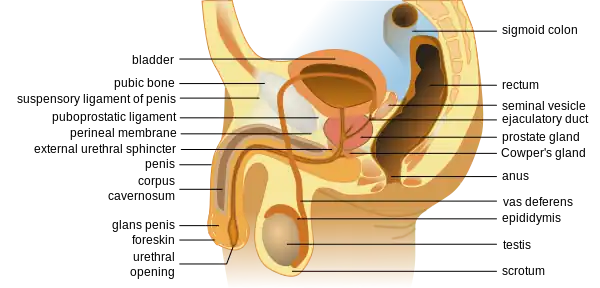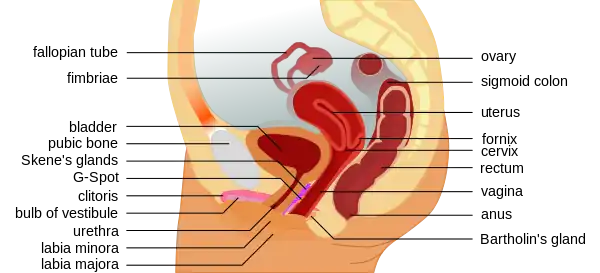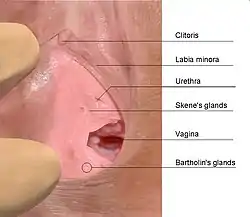Urinary meatus
The urinary meatus[lower-alpha 1] (/miːˈeɪtəs/, mee-AY-təs; PL: meatus or meatuses), also known as the external urethral orifice, is the opening of the urethra. It is the point where urine exits the urethra in both sexes and where semen exits the urethra in males. The meatus has varying degrees of sensitivity to touch. The meatus is located on the glans of the penis or in the vulval vestibule.
| Urinary meatus | |
|---|---|
 Urinary meatus in the penis | |
| Details | |
| Identifiers | |
| Latin | orificium urethrae externum |
| FMA | 19650 |
| Anatomical terminology | |
In human males

The male external urethral orifice is the external opening of the urethra, normally located at the tip of the glans penis, at its junction with the frenular delta. It presents as a vertical slit, possibly bounded on either side by two small labia-like projections, and continues longitudinally along the front aspect of the glans, which facilitates the flow of urine micturition. In some cases, the opening may be more rounded. This can occur naturally or may also occur as a side effect of excessive skin removal during circumcision. The meatus is a sensitive part of the male reproductive system.
In human females

The female external urethral orifice is the external opening of the urethra, from which urine is ejected during urination. It is located about 2.5 cm (1 in) behind the clitoris and immediately in front of the vaginal opening in the vulval vestibule. It usually assumes the form of a short, sagittal cleft with slightly raised margins. To its left and right are the openings of the Skene's glands.
Some evidence exists to suggest that the clitoral-urinary meatus distance (CUMD) in human females relates to the ease with which the female may achieve orgasm through penetrative sex. Orgasm from penetration alone is observed to be more likely as CUMD decreases.[1]
Evidence also suggests that decreased distance from the vaginal opening to the urethral meatus is associated with recurrent post-coital urinary tract infections. [2] Surgical repositioning of the distal urethra to prevent recurrent post-coital urinary tract infections has been employed with some success by Russian physicians.[3]
In other mammals
Unlike most other mammals (including human), female spotted hyenas have a urinary meatus that is located on the clitoral glans.[4][5]
Clinical significance
Congenital disorders of the meatus, in the male, include epispadias (the misplacement to the upper aspect) and hypospadias (the misplacement to the underside of the penis). A congenital misshaping can result in its narrowing (meatal stenosis), causing a partial or total urinary blockage or the bifurcation of the urinary stream. A urethral blockage can also be caused by foreign material, kidney stones, or bladder stones (lithiasis).
Additional images
 A photo of male urinary meatus viewed externally
A photo of male urinary meatus viewed externally The female urinary meatus viewed externally, with surrounding structures labelled
The female urinary meatus viewed externally, with surrounding structures labelled
Notes
- Meatus refers to a tubular opening or passage in the body. From Latin meātus: a course, passing.
References
- Wallen, Kim; Lloyd, Elisabeth A. (2017-03-13). "Female Sexual Arousal: Genital Anatomy and Orgasm in Intercourse". Hormones and Behavior. 59 (5): 780–792. doi:10.1016/j.yhbeh.2010.12.004. ISSN 0018-506X. PMC 3894744. PMID 21195073.
- Gyftopoulos, K; Matkaris, M (2019). "Clinical implications of the anatomical position of the urethra meatus in women with recurrent post-coital cystitis: a case-control study". Int Urogynecol J. 30 (8): 1351–1357. doi:10.1007/s00192-018-3710-7. PMID 29968091. S2CID 49559889.
- Sumerova, Natalia; Pushkar, Dmitry (2011). "Transposition of Distal Urethra in Female Patients with Recurrent Lower UTI Associated with Sexual Intercourse". Clinical Management of Complicated Urinary Tract Infection. doi:10.5772/22301. ISBN 978-953-307-393-4. S2CID 44044908.
- Cunha, Gerald R.; et al. (2014). "Development of the external genitalia: perspectives from the spotted hyena (Crocuta crocuta)". Differentiation. 87 (1): 4–22. doi:10.1016/j.diff.2013.12.003. PMC 4069199. PMID 24582573.
- Drea, C. M.; et al. (2002). "Exposure to naturally circulating androgens during foetal life incurs direct reproductive costs in female spotted hyenas, but is prerequisite for male mating". Proceedings of the Royal Society of London B: Biological Sciences. 269 (1504): 1981–1987. doi:10.1098/rspb.2002.2109. PMC 1691120. PMID 12396496.